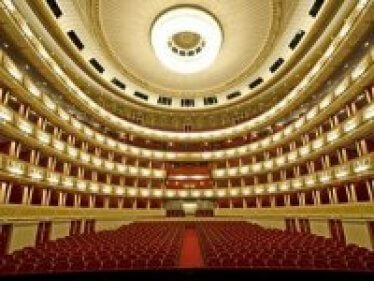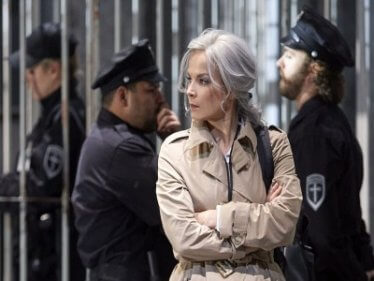Parsifal - Schedule, Program & Tickets
Parsifal
musical direction
Philippe Jordan
Production, stage & costumes
Kirill Serebrennikov
light
Franck Evin
Co-director
Evgeny Kulagin
Collaboration stage
Olga Pavliuk
Collaboration costume
Tatiana Dolmatovskaya
Video & Photo Designer
Aleksei Fokin
Yurii Karih
Combat master
Ran Arthur Brown
dramaturgy
Sergio Morabito
Amfortas
Wolfgang Koch
Gurnemanz
René Pape
Parsifal
Brandon Jovanovich
Klingsor
Wolfgang Koch
Kundry
Anja Kampe
The then Parsifal
Nikolay Sidorenko
The action takes place in the time of the Christian reconquista on the partly Arab-occupied Spanish peninsula. The men's association of the Grail Knights operating there has fallen into crisis. Because knights desert again and again into the counter-realm of the magician Klingsor, who had emasculated himself in his pursuit of sexual asceticism and had previously been rejected by the circle of knights. His castration gave Klingsor the power to rule women. He now uses this to bring down the chaste Christian knights. He was even able to mislead Amfortas, king of the Grail, by stealing his holy spear and inflicting an incurable wound. As a result, Amfortas has turned his ritual duty to unveil the Grail into a torture, which he only performs under the pressure of his "living in the grave" father and which he completely refuses after his death. Only a "pure fool" is destined to undo the fall of grace of the Grail King and to reverse its devastating consequences. A crucial role in this work of salvation is played by an enigmatic woman who travels under different identities both in the area of the Grail Castle and in Klingsor's magic castle.
Wagner's last opera combines in a great way the problems with which the entire oeuvre of the poet-composer confronts us: the avant-garde and romanticism, delimitation and ideology are almost indissolubly interwoven. The genre designation »stage consecration festival« refers to the claim of an art religion. Until the end of the 30-year copyright law, the performance was reserved for the Bayreuth Festival: theater is staged as a ritual. In the atmosphere of the Festspielhaus, racist worldviews flourished, which recommended the ideology of purity of "Parsifal" for anti-Semitic and "völkisch" use.
But it is not the politically compromised romantic messages of salvation that force you to confront Parsifal, but rather the aesthetic new territory that the ingenious musical dramatist opened up: »The romantic magic is over. What is left since the spell failed? The style, the technique, the spirit. Not the spirit of 'pure folly', but the spirit of art, ”wrote the music writer August Halm in 1916. Of course, his voice, one of the few prudent ones, could not prevent the National Socialist abuse that was carried out with the work. But she indirectly referred to the pioneers of an emphatic modernism who inherited the legitimate, namely creative legacy of Parsifal music: the French Debussy, whose world of sound seems to be anticipated in the flower girl scene of the second act, and the Austrian Jews Mahler and Schönberg. The solemn transformation music of the 1st and 3rd act in connection with their bell motif became a decisive influence on Mahler's work, while the prelude to the 3rd act, in which Wagner touches the atonality, anticipates the style of Schönberg.
The not only temporal caesura between the first two and the third act led the director Kirill Serebrennikov, who is also his own set and costume designer, to let the story of the matured Parsifal be told in a flashback, so to speak What happens in the first two acts continues until we arrive in the third act in the presence of the narrator. Serebrennikov associates the dysfunctional male world of the Grail Society with the topography of a prison complex, more precisely a maison centrale, a French prison type in which the so-called hopeless, often members of ethnic or religious minorities, are interned and left to their own devices. The juvenile offender Parsifal is confronted with an initiation ritual in the course of which violence and ecstasy are closely related. In this hermetic male world, the wandering figure of the messenger Kundry is the only woman on the move - with Serebrennikov a journalist who is driven by her interest in the structures of violence that characterize such a maison centrale. In doing so, she acts in a gray area in which she also functions as an accomplice of the inmates.
Attending the performance is recommended from the age of 16.
Subject to changes.
Philippe Jordan
Production, stage & costumes
Kirill Serebrennikov
light
Franck Evin
Co-director
Evgeny Kulagin
Collaboration stage
Olga Pavliuk
Collaboration costume
Tatiana Dolmatovskaya
Video & Photo Designer
Aleksei Fokin
Yurii Karih
Combat master
Ran Arthur Brown
dramaturgy
Sergio Morabito
Amfortas
Wolfgang Koch
Gurnemanz
René Pape
Parsifal
Brandon Jovanovich
Klingsor
Wolfgang Koch
Kundry
Anja Kampe
The then Parsifal
Nikolay Sidorenko
The action takes place in the time of the Christian reconquista on the partly Arab-occupied Spanish peninsula. The men's association of the Grail Knights operating there has fallen into crisis. Because knights desert again and again into the counter-realm of the magician Klingsor, who had emasculated himself in his pursuit of sexual asceticism and had previously been rejected by the circle of knights. His castration gave Klingsor the power to rule women. He now uses this to bring down the chaste Christian knights. He was even able to mislead Amfortas, king of the Grail, by stealing his holy spear and inflicting an incurable wound. As a result, Amfortas has turned his ritual duty to unveil the Grail into a torture, which he only performs under the pressure of his "living in the grave" father and which he completely refuses after his death. Only a "pure fool" is destined to undo the fall of grace of the Grail King and to reverse its devastating consequences. A crucial role in this work of salvation is played by an enigmatic woman who travels under different identities both in the area of the Grail Castle and in Klingsor's magic castle.
Wagner's last opera combines in a great way the problems with which the entire oeuvre of the poet-composer confronts us: the avant-garde and romanticism, delimitation and ideology are almost indissolubly interwoven. The genre designation »stage consecration festival« refers to the claim of an art religion. Until the end of the 30-year copyright law, the performance was reserved for the Bayreuth Festival: theater is staged as a ritual. In the atmosphere of the Festspielhaus, racist worldviews flourished, which recommended the ideology of purity of "Parsifal" for anti-Semitic and "völkisch" use.
But it is not the politically compromised romantic messages of salvation that force you to confront Parsifal, but rather the aesthetic new territory that the ingenious musical dramatist opened up: »The romantic magic is over. What is left since the spell failed? The style, the technique, the spirit. Not the spirit of 'pure folly', but the spirit of art, ”wrote the music writer August Halm in 1916. Of course, his voice, one of the few prudent ones, could not prevent the National Socialist abuse that was carried out with the work. But she indirectly referred to the pioneers of an emphatic modernism who inherited the legitimate, namely creative legacy of Parsifal music: the French Debussy, whose world of sound seems to be anticipated in the flower girl scene of the second act, and the Austrian Jews Mahler and Schönberg. The solemn transformation music of the 1st and 3rd act in connection with their bell motif became a decisive influence on Mahler's work, while the prelude to the 3rd act, in which Wagner touches the atonality, anticipates the style of Schönberg.
The not only temporal caesura between the first two and the third act led the director Kirill Serebrennikov, who is also his own set and costume designer, to let the story of the matured Parsifal be told in a flashback, so to speak What happens in the first two acts continues until we arrive in the third act in the presence of the narrator. Serebrennikov associates the dysfunctional male world of the Grail Society with the topography of a prison complex, more precisely a maison centrale, a French prison type in which the so-called hopeless, often members of ethnic or religious minorities, are interned and left to their own devices. The juvenile offender Parsifal is confronted with an initiation ritual in the course of which violence and ecstasy are closely related. In this hermetic male world, the wandering figure of the messenger Kundry is the only woman on the move - with Serebrennikov a journalist who is driven by her interest in the structures of violence that characterize such a maison centrale. In doing so, she acts in a gray area in which she also functions as an accomplice of the inmates.
Attending the performance is recommended from the age of 16.
Subject to changes.
There are no products matching the selection.




